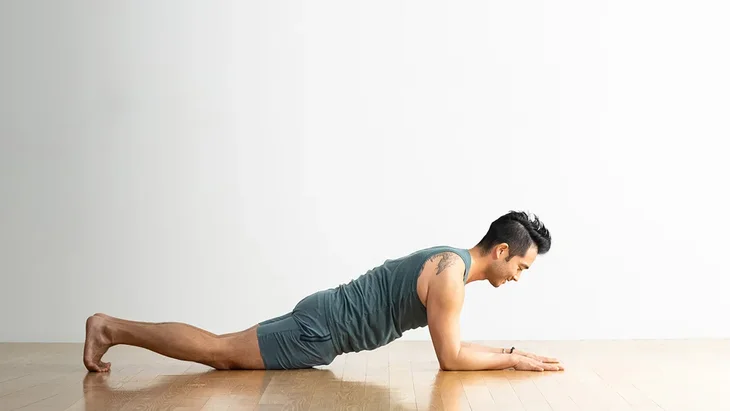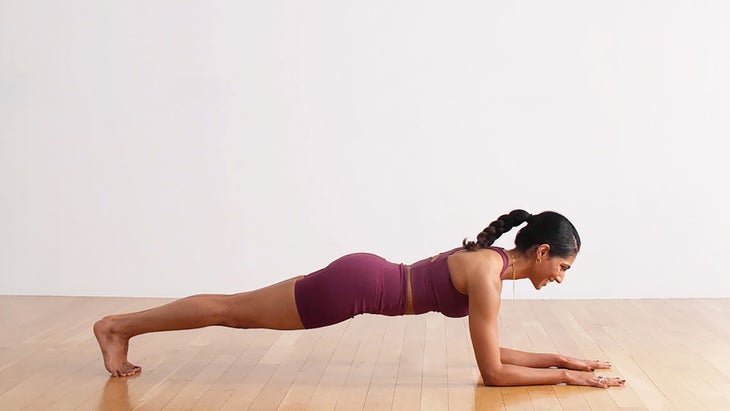“], “filter”: { “nextExceptions”: “img, blockquote, div”, “nextContainsExceptions”: “img, blockquote, a.btn, a.o-button”} }”>
You know those days when you need to be incredibly efficient with whatever time you can spare for a yoga practice or a workout? Those are the days when you want to rely on the full-body workout provided by Forearm Plank.
The posture engages your core, shoulders, arms, and legs. But beyond strengthening your body, Forearm Plank also focuses your thoughts, slows your breath, and reminds you that yes, you can do difficult things. (Also, it teaches you that you don’t have to like those difficult things for them to benefit you!)
You can incorporate any of the following variations of Forearm Plank into your yoga practice or gym workout or, on those days when you literally have only a minute or two to spare, you can turn it into a practice by itself.
3 Ways to Practice Forearm Plank
1. Forearm Plank
Start in Plank Pose. Place one forearm on the floor, followed by the other. As you breathe slowly and steadily, align your shoulders directly over your elbows and keep your chest parallel to the floor. Press your inner forearms and elbows firmly against the floor. Firm your shoulder blades against your back and spread them away from your spine. Spread your collarbones away from your sternum.
Draw your navel toward your spine. Hug your outer hips and inner thighs toward your midline. Press your thighs toward the ceiling and lengthen your tailbone toward your heels. Look straight down at the floor and reach the base of your skull away from the back of your neck. And while you’re doing all that, keep your throat and eyes soft. If you notice your elbows splaying out to the sides, adjust a strap shoulder-distance apart and slide it above your elbows.
Breathe and stay in the pose for anywhere from 30 seconds to 1 minute. Release your knees to the floor and press back into Child’s Pose or lift your hips and knees to press up and back into Downward Facing Dog.

2. Forearm Plank With Knees Down
Start in Tabletop. Move one knee at a time one to two feet back. Place one forearm on the floor, followed by the other. Align your shoulders directly over your elbows and keep your torso parallel to the floor. Tuck your hips under slightly. Hug your outer hips and inner thighs toward your midline to help you engage your core.
Press your inner forearms and elbows firmly against the floor. Firm your shoulder blades against your back and spread them away from your spine. Similarly, spread your collarbones away from your sternum. Press your front thighs toward the ceiling, but resist your tailbone toward the floor as you lengthen it toward your heels. Lift the base of your skull away from the back of your neck and look straight down at the floor, keeping your throat and eyes soft.
Stay anywhere from 30 seconds to a minute. Then shift your hips toward your heels to press back to Balansana (Child’s Pose).

3. Forearm Plank Against a Wall
Stand about two footprints’ distance from a wall with your feet hip-width apart. Place your forearms against the wall, bringing your elbows directly beneath your shoulders. Keep your chest and legs parallel to the wall. Press your palms, inner forearms, and elbows against the wall. Firm your shoulder blades against your back and spread them away from your spine. Similarly, spread your collarbones away from your sternum.
Press your front thighs slightly away from the wall and hug your outer hips and inner thighs toward your midline to help you engage your core. Lengthen along your backside. Lift the base of your skull away from the back of your neck and look straight at the wall, keeping your throat and eyes soft. Lift your heels if you like.
Stay here for anywhere from 30 seconds to 1 minute. Then, replace one elbow at a time with your palm and release away from the wall.
RELATED: 8 Ways to Use the Wall in Your Yoga Practice
This article has been updated. Originally published September 27, 2020.

